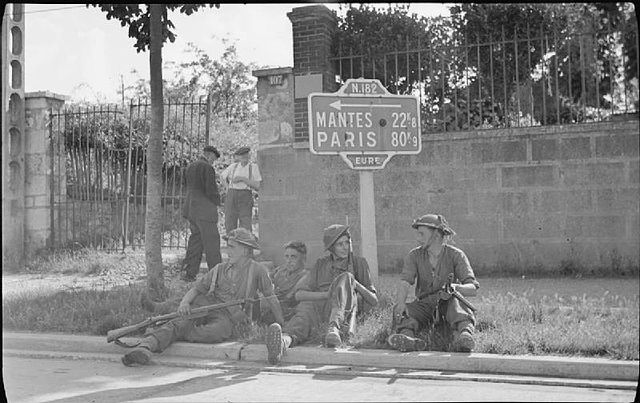
Next for Europe: Defining its own battlefield tactics

The author, Michael Benhamou, is the Executive Director of OPEWI. Formerly, he served as a Political Advisor for NATO and EU operations.
This article was originally published and financed by the Wilfried Martens Centre for European Studies, in its European View magazine.
Abstract
Now that European defence budgets are (finally) on the rise, Europe’s military circles are faced with one issue that has not been addressed at EU level: how do they want to fight? The US-led NATO alliance rightfully coordinates all doctrinal work in Europe at the moment, but the time to discuss how soldiers and weapons function in larger operations is coming, considering the US’s gradual withdrawal amid increasing turmoil in the neighbourhood. Having these field concepts in place would demonstrate the determination and cohesiveness of Europe of today while shaping the military procurement of tomorrow.
Introduction
On 24 February 2022, Russia launched a full-scale invasion of Ukraine that shook European defence planners to their core. The EU was then in the process of ratifying a brand-new document entitled its ‘Strategic Compass’. In its introduction, the latter stated that Europe’s main threat was ‘dysfunctional governance and contestation in our wider neighbourhood and beyond, sometimes nourished by inequalities, religious and ethnic tensions, increasingly entangled with non-conventional and transnational threats and geopolitical power rivalry.’ (EEAS 2022, 17).
Based on that vision, quasi-outdated before the release of the document, the Compass called for the creation of an EU Rapid Deployment Capacity of 5,000 soldiers—ʻan actionable proposal’, Josep Borrell, the EU’s chief diplomat, defensively claimed (EEAS 2022, 6). An operational ramp-up has been set in motion, but with just 5,000 troops involved, what can Europeans truly learn about their own fighting ways? We are far from the 60,000-soldier target set at the Helsinki European Council of 1999 (European Council 1999), and even further away from the 600,000 (Ukrainian and Russian) troops currently fighting in Ukraine (Gros and Tourret 2023, 21; Tenenbaum 2023, 18).
So far, the EU has only carried out small-scale crisis-management or post-conflict operations, and these deployments have shied away from the larger combat scenarios of today and tomorrow—scenarios that will force Europeans to recover their old tactical skills. To make the case for a truly European Tactical Compass, this article will first present some assumptions about the near future. It will then define the term ‘tactic’. Once these foundations have been laid, three points of attention will follow: (1) on the balance between defence and offence in battle, (2) on the need to revitalise European land forces, and (3) on the hazardous seduction of full intelligence knowledge. Finally, recommendations will close the analysis.
Assumptions
The following assumptions about the near future have been made for the purposes of this article:
- The US will likely continue to deprioritise Europe—today’s support for Ukraine being the exception to the rule. Several underlying trends support this hypothesis. The first is the acceleration of America’s ethnic diversification, whereby its European-enthusiast white population is expected to fall below 50% by 2045 (Frey 2018). Second, several polls have indicated that US voters have increasingly volatile feelings about foreign engagements. Republicans also express more persistent isolationist feelings (Daalder et al. 2022, 19). Third and finally, the US military presence abroad is already on a downward trend: since 2008 Pentagon bases in Asia have employed more personnel than those in Europe and the gap is increasing (Allen 2021).
- The severity of the effects of climate change will likely increase all over Europe, but particularly in the Mediterranean region where soil draining and coastal flooding are already provoking water and/or cereal shortages, thus destabilising and already constraining Southern Europe and the Middle East (IPCC 2022, 2242).
- The growing scarcity of fossil fuels and rare minerals (Shift 2021) will further contract global supply chains and make any military efforts more costly and difficult to sustain. With poverty on the rise, violence will likely become more desperate and unpredictable as the risk increases of fragile states collapsing or of populations rallying behind authoritarian solutions.
- As a wealthy and innovative part of the world, geographically connected to the Eurasian continent, the Middle East and Africa, the EU will face increasing security threats from its neighbourhood in the coming decades—both from the east and the south. However, Europe should still be backed by the US’s (scaled-down) support and by its ability to disrupt our century’s downward trajectory through technological breakthroughs.
Defining tactics
Before any physical shock, that is, the shock of metal driven by courage, war is an intellectual struggle. There is nothing more fascinating than seeing Napoleon’s offices at Fontainebleau or Malmaison full of books—on philosophy, physics, theatre plays, military history, agronomy and so on. The French emperor even carried a cherished fraction of this library in a small trunk during battles.
Today, however, relying perhaps too much on the US’s intellectual resources, Europeans have lost this appetite for thinking about warfare and doctrines. The terms ‘tactics’ and ‘tactical’ barely appear in EU security and defence documents. Accordingly, today’s command systems are mostly defined by Russian and American politico-military manuals: a strategic level that links objectives set by political leaders with a broad military design; an operational level that coordinates the different geographies to bind the different theatres of operation together; and finally a tactical level that wins (or loses) local battles (Yakovleff 2016, 34–42).
Paraphrasing the late Prussian military thinker, Clausewitz, one should be reminded of the obvious aim of all this ink: imposing one’s will on the opponent, tactical warfare being the level that decides victory (Aron 1987, 33).
Nothing groundbreaking in any of this so far, yet now that Europeans are taking back the long-abandoned field of defence, one of their first challenges is to reclaim its references and its semantic field. It is dangerous to plan military operations based on concepts established abroad—concepts that are disconnected from the actual means at our disposal, and also disconnected from the particularities of our geography and our history. From this point of view, the psychological block that is the Second World War must be overcome, most notably in Central Europe. Shame or guilt cannot be a guiding star: all of Europe’s past should be studied to prepare for tomorrow’s battles.
The next three sections will exemplify this argument.
Remembering defence
Let us start with a quick detour through sports. Notice the difference between the evolution of US-led games (basketball, boxing) and of European ones (football, rugby)?
There are now so many fouls whistled by referees in basketball that its defenders have become powerless, and Mohammed Ali’s old, thick boxing gloves have been replaced by the more brutal Mixed Martial Arts, where all kicks are allowed (Hehir 2021; Chopra 2023). Meanwhile, France currently wins a lot of rugby and football games, often with limited ball possession but always with a strong defence. The latter may be frustrating for opponents to watch but few fans will say at the end of the game that France did not deserve to win. Europeans respect defence.
This transatlantic delta is no coincidence: it reveals deeper subconscious choices driven by where the two sides currently stand on the world stage. Americans live on a powerful entertainment-galore island. Europeans face a more tragic neighbourhood with numerous challenges or adversaries either connected directly by land or by a ‘narrow Mediterranean river’ (Braudel 1949, 267).
This cognitive gap leads to differences of opinion that can be found at the heart of NATO’s tactical manuals. Recent (US-inspired) editions correlate offensive tactics with ‘a proactive mindset . . . that fosters confidence and a culture of success and achievement’ (NATO 2019, 31). Another NATO doctrine explains the ‘manoeuvrist approach’: an impressive ‘combination of fire and movement’ that seeks to disrupt the enemy’s centre of gravity instead of gaining ground on the opponent (NATO 2022, 37–41).
Yet, such a planning mindset requires ammunitions or logistical means that one does not necessarily have and assumes that the enemy will be defeated at a pace dictated to him. Therefore, by systematising offence and indirectly equating defence with a losing attitude, one may rush into a deadly offensive trap while failing to grasp the potential of early defensive opportunities: on certain occasions, commanders may want to sacrifice space to gain time (to expose the attacker’s plan, identify logistical vulnerabilities, impose a higher attrition rate while waiting for reinforcements, etc.).
Europe’s history is filled with heroic and (sometimes) successful defensive manoeuvres. These include the Duke of Wellington hiding his infantry behind a Waterloo hill before the final blow to Napoleon (1815), the stone-faced General Joffre transferring thousands of French troops to block and repel the German offensive at the beginning of the First World War (1914), the incredible Finnish guerrilla tactics that slowed down and exhausted Soviet winter attacks (1939–40), and Germany’s solid mountain lines of defence against Allied soldiers in the Abruzzo during the Second World War (1943–4).
Everything compels Europe to have an open mind with regard to both attack and defence postures—its numerous rivers, the height of its mountains, the forested depth of certain plains, the variety of its mentalities and related behaviours, the resilience of nearby adversaries who are not afraid of death and destruction, or, on the contrary, who can be misled by a certain imperial romanticism. The Ukrainian Army has recently joined this long European tradition by resisting Russian aims (2022–3).
Rebalancing towards land forces
These frictions over the philosophy of combat often stem from the following dichotomy: the fascination of the US (and Britain) with air and naval power, while the European continent has to spread its resources between air, naval and land forces—or between land and air forces for landlocked nations (see Table 1).
Yet, observing the European countries in Table 1, one notices the budgetary importance attributed to naval and air forces in the North and West of Europe, while the East primarily focuses on land force expenditure (with the exception of Slovakia). Our calculations show that the East allocates close to 60% of military funds to its land forces, while that percentage stands at 36% in Western Europe and at 37% in the North. Obviously, the absence of or limited nature of coasts plays a part in these variations, but for the East it is also about matching its own threat perception—as countries with imperial dreams such as Russia and Turkey tend to throw their military weight behind land units as well (see bottom of Table 1).
Table 1 Budgetary share of each component in the land, navy and air forces

Note: The shading (from light to dark) highlights the increasing proportion of expenditure in per cent of total land/navy/air forces. Most budgetary numbers are drawn from 2022 country reports from MILEX. For those figures taken from the EDF, we have added together the budgetary actions from 2021-3 (EDF 2023, 42). For the UK, figures for 2022–32 were used (UK, Ministry of Defence 2022, 24). Budgetary methodologies differ between countries. ‘Space’ budget lines were removed from air force calculations.
The table shows that EU institutions are, overall, perfectly aligned with US allocations: 26% for land projects, 38% for naval forces and 36% for air forces (EDF 2023). An official EU audit of all (known) European defence investments goes further, assessing that 23% of military spending goes to land projects, 23% to naval ones and 54% to air forces (EDA 2022, 3). If one adds cyber and space to the ‘air’ category, the ratio increases to 57%. Recent statements have supported these budgetary choices: ‘lessons’ from the war in Ukraine rarely highlight the support for infantry or artillery. Command and control, electronic warfare, air and missile defence, and air defence systems often get more granular attention (EEAS 2023).
In this sense, the EU’s capability strategy mirrors that of the US. Air research and capabilities are considered ‘critical’ in many EU documents; identified shortfalls are often either air or navy-related (EDA 2022, 13). As for the aforementioned 5,000-strong Rapid Deployment Capacity, this is merely the size of a US land brigade.
Such funding targets, which constrain the next 10–20 years, have been enacted despite the more terrestrial realities of Eastern Europe and what the war in Ukraine displays every day on our screens—namely the return of infantry, tanks, artillery, military engineering and heavy land logistics. The war in Ukraine has taught us that air dominance is not a given in Europe’s neighbourhood. Redesigning our air forces is vital, but one should be able to plan without them as well.
This poses an intermediate question: is Europe (involuntarily) trying to reach a tactical division of labour by 2030–40, with the East leading land warfare, the North handling air forces and the South, France and the UK commanding maritime assets, for example?
In the absence of such a clarified and agreed-upon intent, the popularity of air–sea assets, reinforced by America’s new efforts to contain the rise of China over the vast Pacific, not only has consequences with regard to uncoordinated equipment levels, but also damaging behavioural ones for Europeans. ‘Air-to-air combat encourages the annihilation of the adversary’, wrote German jurist Carl Schmitt, ‘in that human contact with the population is broken. Thus [in the heat of battle], there will be a tendency to compensate for the difficulty of limiting the absolute war one is accelerating by making the adversary more criminal than he is’ (Schmitt 1950, 315).
Certain European countries seem fully aware of this risk. NATO’s unclassified doctrines are filled with reservations that make this point. The French, for instance, argue that greater control should be attributed to the land-forces commander in order to tame air and sea effects during battle (NATO 2022, 13). Conversely, in NATO’s targeting doctrine, the US states that the document’s approach (read: Europe’s approach) to protecting civilians is too soft: ‘civilians who take part in hostilities forfeit their protection from being made the object of an attack . . . the US reserves the right to follow US doctrine’ (NATO 2021, 9).
This brings us back to the matter of collateral damage, which troubled headquarters in Afghanistan and the Middle East recently, but also to Europe’s specific military position on the map: with so many neighbours all around, it is ill-advised to be like Michael Jordan in a china shop.
Seeing what the fog of war allows
At this point, military technology experts from the US may reply that Michael Jordan has actually never been so thin and agile. The correlation of brute air force with approximate blunders is in the past, according to them. The ongoing war in Ukraine exemplifies the information dominance that is possible by fusing intelligence sources—human interactions, drones, planes, satellites and electronic data (Gros and Tourret 2023, 59–61)—all processed by artificial intelligence.
Admittedly, the precision of intelligence and of strikes is unheard of. This author cannot deny the power of joint, concentrated headquarters, enabling commanders to make fast and informed decisions.
Yet, adversaries tend to find counter-moves: surface-to-air missiles, telecommunications jamming, spatial lasers to disable GPS tracking and more. What do we do then, as Europeans, if we rely too much on such high-tech equipment whose maintenance is sometimes out of reach? What if a sudden telecommunications paralysis gives opportunities to an adversary with better land forces and a greater ability to use them? What if human field liaisons (replaced by virtual avatars) and old skills such as mental arithmetic or the understanding of local power dynamics were to disappear just at that moment when they are most useful? What will become of human intuition when we have delegated all thought processes to machines whose costs keep on rising while their supply chain becomes increasingly unstable?
Western countries have onviously been getting used to luxurious habits. Battle Damage Assessments, for instance, come with highly precise figures about enemy casualties: a critical piece of information in battle. A lot of commentators on the war in Ukraine express huge confidence in them—sharing precise figures for the number of Russian bodies every day on YouTube (UNTV 2023). More realistically, decision-making during combat always takes place in an atmosphere of information overload, stress, cultural misunderstanding, fatigue, misinformation and rumours. The use of sophisticated systems will not replace the need for unpredictable physical engagement in upcoming wars. Europe’s adversaries are openly betting on our mental weakness once our initial tech-heavy attack has been exhausted (Benhamou 2015).
And so ‘what is the point of accumulating knowledge if we become more cowardly in the process?’, asked French philosopher Montaigne (1580, 263). This is still pertinent, five centuries later.
Conclusion and recommendations
Europe should reconnect with its past and adapt the EU’s defence plans to suit local parameters—Russia, the Middle East, Africa, climate change, and European topography and mentalities. Not doing so would be to risk developing the wrong weapons and preparing for the wrong battles.
I make three recommendations based on this assessment:
- The EU Military Staff should step up on the matter of tactical doctrines and work with experienced NATO counterparts on this front. The Concepts Directorate or Operations Directorate could arrange for a European build up both within and outside of NATO, demonstrating to our American partners that Europeans are capable of planning larger operations with autonomy and responsiveness.
- Although insufficient in volume and removed from kinetic ambitions, the EU should make the most of the upcoming operational-level exercises in 2023, 2024 and 2025. Testing the EU Battle Groups and the EU Rapid Deployment Capacity is the first step on this long and winding road (Howorth 2023).
- An annual conference, perhaps entitled ‘Europe’s Battlefield Conversation’, should be organised, at which EU member states could share threat assessments, anticipate tactical postures and adjust weapons system with the European Defence Agency and NATO allies. In terms of location, I would suggest Potsdam to draw inspiration from Frederick the Great himself: it offers the home of this tactical innovator as well as French architectural patterns, and is representative of Europe’s new military centre of gravity—and is thus both symbolic and energising.
Is it too soon? Are we risking the transatlantic bond with such proposals? Europeans fail to understand that our partners and foes alike only respect willpower. As Americans diversify their geopolitical priorities, Europe’s tactical ownership is coming; but will it be at a pace dictated by external events? Worryingly, that is often the case when European defence matters are at stake, but let us leave our hearts open to being surprised.
References
Allen, M., Flynn, M., & Machain, C.-M. (2021). US global military deployments (1950–2020). Conflict Management and Peace Science. doi:10.1177/07388942211030885.
Aron, R. (1987). Sur Clausewitz. Paris: Editions Complexe.
Benhamou, M. (2015). The West and the return of violence. European View. doi:10.1007/s12290-015-0366-2.
Borrell, J. (2023). Lessons from the war in Ukraine for the future of EU defence. European External Action Service, HR/VP Blog, 29 May. https://www.eeas.europa.eu/eeas/lessons-war-ukraine-future-eu-defence_en. Accessed 5 June 2023.
Braudel, F. (1949). La méditerranée et le monde méditerranéen à l’époque de Philippe II, volume 1 : la part du milieu. Malakoff: Editions Armand Colin.
Chopra, G. (director). (2023). ‘McGregor Forever’. Netflix.
Daalder, I., Friedhoff, C., Kafura, C., Smeltz, D., Sullivan, E. (2022). 2022 survey of public opinion on US foreign policy. Chicago Council on Global Affairs. Chicago. https://globalaffairs.org/research/public-opinion-survey/2022-chicago-council-survey. Accessed 31 May 2023.
EDA (European Defence Agency). (2022). 2022 Coordinated Annual Review on Defence report. November. https://eda.europa.eu/what-we-do/EU-defence-initiatives/coordinated-annual-review-on-defence-(card). Accessed 2 June 2023.
EDF (European Defence Fund). (2023). Indicative Multiannual perspective 2021-2027. Accessed 29 March 2023. https://www.google.com/url?sa=t&rct=j&q=&esrc=s&source=web&cd=&cad=rja&uact=8&ved=2ahUKEwie_rTXrP-AAxXsY6QEHZygAIAQFnoECBAQAQ&url=https%3A%2F%2Fdefence-industry-space.ec.europa.eu%2Fsystem%2Ffiles%2F2023-03%2FEDF%2520Indicative%2520multiannual%2520perspective.pdf&usg=AOvVaw3rDbEs950UifsrpN1UAN-3&opi=89978449.Accessed 2 June 2023.
EEAS (European External Action Service). (2022). A strategic compass for security and defence. 24 March. https://www.eeas.europa.eu/eeas/strategic-compass-security-and-defence-0_en. Accessed 31 May 2023.
European Council. (1999). Helsinki European Council, 10 and 11 December 1999 – Presidency conclusions. https://www.europarl.europa.eu/summits/hel2_en.htm. Accessed 31 May 2023.
Frey, H. (2018). The US will become ‘minority white’ in 2045, census projects. Brookings Institution, 14 March. https://www.brookings.edu/blog/the-avenue/2018/03/14/the-us-will-become-minority-white-in-2045-census-projects/. Accessed 31 May 2023.
Gros, P., & Tourret, P. (2023). Guerre en Ukraine : analyse militaire et perspectives. Fondation pour la Recherche Stratégique. Paris. https://www.frstrategie.org/publications/recherches-et-documents/guerre-ukraine-analyse-militaire-perspectives-2023. Accessed 31 May 2023.
Hehir, J. (director). (2020). ‘The Last Dance’. Netflix.
Howorth, J. (2023). The Ukrainian war and its implications for European security. Martens Centre. Brussels, May. https://www.martenscentre.eu/publication/the-ukraine-war-and-its-implications-for-european-security/. Accessed 31 May 2023.
IPCC (International Panel on Climate Change). (2022). IPCC sixth assessment report. https://www.ipcc.ch/report/ar6/wg2/. Accessed 31 May 2023.
MILEX (Military Expenditures). (n.d.). National reports. https://milex.un-arm.org/national-reports. Accessed 2 June 2023.
Montaigne, M. (1580). Les essais (volume I). Paris: Editions Pléiade.
NATO. (2019). Allied joint doctrine for the conduct of operations (AJP-3). Edition C, version 1.
NATO. (2021). Allied joint doctrine for joint targeting (ajp-3.9). Edition B, version 1. November.
NATO. (2022). Allied joint doctrine for land operations (ajp-3.2). Edition B, version 1.
Schmitt, C. (1950). The Nomos of the Earth. Paris: Editions Quadrige.
Tenenbaum, E. (2023). Haute intensité: quels défis pour les armées françaises ? French Institute of International Relations. Paris, July. https://www.ifri.org/fr/publications/notes-de-lifri/haute-intensite-defis-armees-francaises. Accessed 19 July 2023.
The Shift Project. (2021). Future oil supply: What are the risks for Europe? May. https://theshiftproject.org/en/article/oil-what-are-the-risks-for-the-future-of-europes-supply-the-new-shifts-report-about-peak-oil/. Accessed 31 May 2023.
UK, Ministry of Defence. (2022). The defence equipment plan 2022 to 2032. November. https://www.gov.uk/government/publications/the-defence-equipment-plan-2022-to-2032. Accessed 2 June 2023.
UNTV (Ukraine News TV). (2023). Ukraine war map. YouTube. https://www.youtube.com/@AutocracyTV. Accessed 2 June 2023.
Yakovleff, M. (2016). Tactique théorique. Paris: Edition Economica.
Image Credit: Wikimedia Commons, Public Domain: https://commons.wikimedia.org/wiki/File:The_British_Army_in_North-west_Europe_1944-45_BU56.jpg


